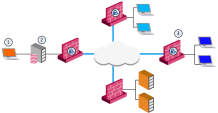How SmartView Monitor Works
Data for the status of all Security Gateways in the system is collected by the Security Management Server![]() Dedicated Check Point server that runs Check Point software to manage the objects and policies in a Check Point environment within a single management Domain. Synonym: Single-Domain Security Management Server. and viewed in SmartView Monitor.
Dedicated Check Point server that runs Check Point software to manage the objects and policies in a Check Point environment within a single management Domain. Synonym: Single-Domain Security Management Server. and viewed in SmartView Monitor.
The data shows status for:
-
Check Point Security Gateways
-
OPSEC Gateways
-
Check Point Software Blades
Gateway Status is the SmartView Monitor view, which shows all component status information.
A Gateway Status view shows a snapshot of all Software Blades, such as VPN and ClusterXL, and third party products (for example, OPSEC Gateways).
Gateway Status is similar in operation to the SNMP daemon that provides a mechanism to get data about Gateways in the system.
SIC![]() Secure Internal Communication. The Check Point proprietary mechanism with which Check Point computers that run Check Point software authenticate each other over SSL, for secure communication. This authentication is based on the certificates issued by the ICA on a Check Point Management Server. is initialized between Security Gateways (3) (local and remote), and the Security Management Server
Secure Internal Communication. The Check Point proprietary mechanism with which Check Point computers that run Check Point software authenticate each other over SSL, for secure communication. This authentication is based on the certificates issued by the ICA on a Check Point Management Server. is initialized between Security Gateways (3) (local and remote), and the Security Management Server![]() Check Point Single-Domain Security Management Server or a Multi-Domain Security Management Server. (2). The Security Management Server then gets status data from the Software Blades with the AMON (Application Monitoring)protocol. SmartView Monitor (1) gets the data from the Security Management Server.
Check Point Single-Domain Security Management Server or a Multi-Domain Security Management Server. (2). The Security Management Server then gets status data from the Software Blades with the AMON (Application Monitoring)protocol. SmartView Monitor (1) gets the data from the Security Management Server.
AMON Protocol Support
The Security Management Server acts as an AMON client. It collects data about installed Software Blades. Each Security Gateway![]() Dedicated Check Point server that runs Check Point software to inspect traffic and enforce Security Policies for connected network resources., or any other OPSEC Gateway, which runs an AMON server, acts as the AMON server itself. The Gateway requests status updates from other components, such as the Firewall kernel and network servers. Requests are fetched at a defined interval.
Dedicated Check Point server that runs Check Point software to inspect traffic and enforce Security Policies for connected network resources., or any other OPSEC Gateway, which runs an AMON server, acts as the AMON server itself. The Gateway requests status updates from other components, such as the Firewall kernel and network servers. Requests are fetched at a defined interval.
An alternate source for status collection can be any AMON client, such as an OPSEC partner, which uses the AMON protocol.
The AMON protocol is SIC- based. It can collect data only after SIC is initialized.
Defining Status Fetch Frequency
The Security Management Server collects status data from the Security Gateways on a defined interval. The default is 60 seconds.
To set the Status Fetching Interval:
-
Open Global Properties > Log and Alert > Time Settings.
-
Enter the number of seconds in Status fetching interval.

